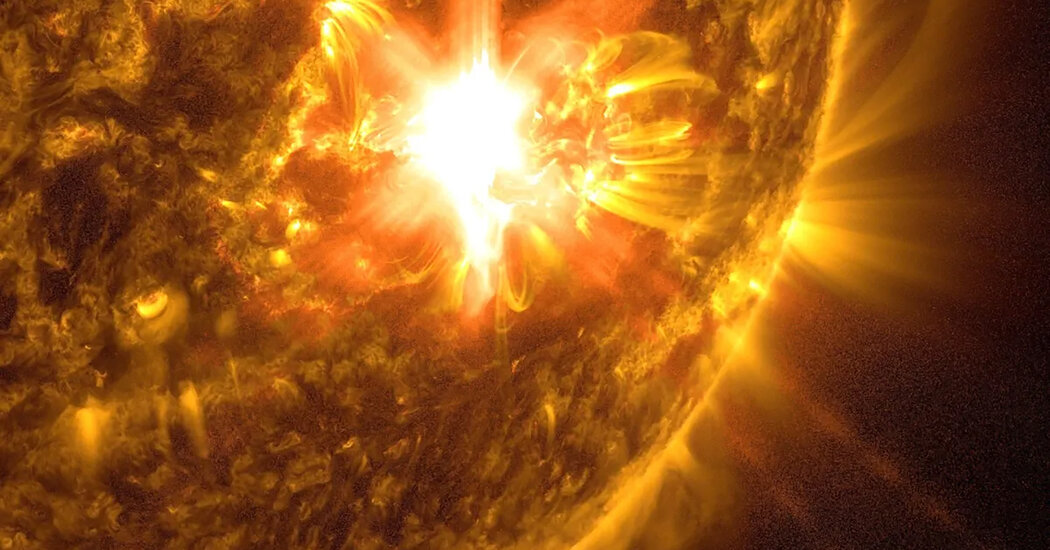Night skies in many parts of the Northern Hemisphere are expected to bloom again on Saturday night with the vivid colors of the northern lights, or aurora borealis, as a powerful geomagnetic storm caused by a hyperactive sun persists through the weekend.
The National Oceanic and Atmospheric Administration, which monitors space weather, said in an update on Saturday that it continued to observe solar activity that could lead to periods of “severe-extreme” geomagnetic storms. The federal agency first issued a warning on Friday as bursts of material from the sun’s surface traveled into Earth’s atmosphere, causing irregularities in power, navigation and communication systems.
Major power utilities had largely prepared their electrical grids for the solar storm, and their customers were unaffected.
For most people, the solar storm was a gift: It caused ribbons of pink, purple and green light across night skies of much of the United States, Canada and Europe. Where evening skies are clear on Saturday, the lights can be expected again.
Known as aurora, the light is caused by particles from the sun interacting with gases in Earth’s atmosphere, and is usually only observed at latitudes closer to the North or South Pole. But on Friday night, residents of lower latitudes, including those in North Carolina and Arizona, saw the dancing lights.
Jane Wong, 30, of San Francisco, drove to the Presidio overlooking the Golden Gate Bridge where conditions started out foggy. But at midnight, her wait paid off as the sky started to clear.
“It’s right here, which is really magnificent,” she said.
Benjamin Williamson, 41, of Bath, Maine, drove to the Portland Head Light, a lighthouse in the state. An aurora enthusiast, he’d seen the northern lights during another major solar event in 2003, and in Iceland in 2017. None of those events, nor the April 8 solar eclipse, prepared him for what he saw on Friday.
“The solar eclipse last month, I thought that was the coolest thing I’d ever seen,” he said. “This might have beat it.”
Solar storms are caused by violent expulsions of charged particles from the sun’s surface. When directed toward Earth the material can interact with our planet’s magnetic field, resulting in a geomagnetic storm.
NOAA categorizes geomagnetic storms on a “G” scale of 1, or “minor,” to 5, “extreme.” On Thursday, the agency issued its first watch in 19 years for a G4, or “severe,” storm, which escalated into a warning on Friday afternoon.
Activity has exceeded the agency’s prediction, and some of it is now classified as G5, making it the strongest storm to reach Earth since October 2003.
The storm is caused by a giant cluster of sunspots, or dark, cool regions on the solar surface with strong magnetic fields. (If you still have your eclipse glasses handy, you may be able to see the sunspots during the day.) According to NOAA, the cluster will continue to flare and explode, with effects on Earth through at least the weekend. In 1989, a geomagnetic disturbance disrupted power systems in Canada and the United States. Energy providers have been on guard ever since.
“The utilities have been preparing for a large storm with the required vulnerability assessments,” said Bob Arritt, a technical executive at the Electric Power Research Institute, an independent research and development organization.
Some utilities saw high temperature alarms triggered overnight on parts of the electric grid, Mr. Arritt said, but added that it was too early to know if the alarms were related to the solar storm. He said he could not disclose the locations of the alerts as of Saturday.
But while the power system faced some additional stress from the storm, he added, “We have no reason to feel that there is any imminent threat to damaging equipment.”
The solar storm prompted managers of a number of electric grids to take extra precautions to keep electricity flowing, and to issue warnings to customers about potential disruptions.
PJM, the manager of the nation’s largest grid network across 13 states from the East Coast to the Midwest, said its geomagnetic disturbance warning would continue through the end of Saturday. ISO New England, which manages the electric grid for six states in the Northeast, issued a precautionary alert, which notified participants in wholesale energy markets and owners of electrical generation equipment that abnormal conditions are present on the power system.
